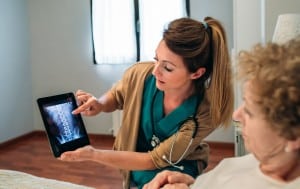Our Transitioning Through Menopause support group provides women evidence-based information to make good decisions about their health.
Experts recently addressed bone health, which is a big concern for women as they enter menopause due to dropping estrogen levels.
An experienced provider can help you make lifestyle changes and, if necessary, find medications to strengthen your bones and reduce your risk of fractures.
Women start to lose bone mass in their 30s, but that doesn’t mean they are doomed to weakness and injuries as they age. A provider with expertise and experience caring for women during menopause can help you gauge and address your risk for fractures.
Regional One Health’s Transitioning Through Menopause support group gives women guidance on bone health and other relevant health topics, like hot flashes, sexual health and breast health.
The group, which is led by certified menopause practitioners Diane Todd Pace, PhD, APRN, FNP-BC, NCMP, FAANP, FAAN, and Pallavi Khanna, MD, OB/GYN, FACOG, meets virtually the first Thursday of each month at noon. With the help of fellow health experts, they provide evidence-based information women can use to improve their wellness as they age.
Joshua Morris, MD, and OB/GYN and Certified Menopause Practitioner, recently addressed the issue of bone health.
“Our bones let us live active, healthy lives. They help us move. They provide our basic strength. They protect our vital organs,” he said. “It’s important to have a conversation with your provider about your personal risks and goals.”
Bone health is crucial for menopausal women because aging and being female are two of the top risk factors for osteopenia (loss of bone mass) and osteoporosis (brittle bones).

There are various scans and tests available that can help you gauge your bone health and risk of fractures.
As Dr. Morris noted, the bones are a living, active organ. “They’re constantly forming and being broken down, and those two opposite activities are driven by two different types of cells. Your bone health is determined by which of these cells is doing more than the other at any given time.”
During perimenopause and menopause, bone density losses speed up because the body produces less estrogen, which makes the cells that cause bone loss more active. While lower estrogen is an inevitable part of aging, weak bones are not.
Improving your diet is the first step. Calcium-rich foods like low-fat milk, yogurts and cheeses; leafy green vegetables like kale and spinach; and fortified cereals and breads are good options.
Calcium supplements are less of a sure thing, Pace cautioned. They are not regulated by the Food and Drug Administration, so products can be inconsistent or ineffective. Also, they can interact with other medications and have negative side effects including cardiovascular risks.
Vitamin D, another key player in bone health, is also best derived from natural sources – safe sun exposure and foods including fatty fish like salmon or tuna, egg yolks and milk.
A bone-healthy diet also means avoiding excess alcohol and cigarettes.
Weight-bearing exercise is another way to build stronger bones. Walking, dancing, stair climbing, elliptical machines and active gardening are good options: “Choose whatever will get you active and moving and continue doing that as

Weight-bearing exercise like walking, dancing and active gardening is a great way to build stronger bones.
long as possible,” Dr. Morris said.
Finally, women should learn their risk and find a provider who can help them manage it. Talk to your primary care provider about your screening needs.
The FRAX, or Fracture Risk Assessment, calculates your 10-year probability of a fracture based on gender, age, race, body mass index, tobacco and alcohol use and other factors.
A DEXA scan is recommended for women starting at age 65. High-risk women may need to start screening sooner, especially if they’ve had a “low-trauma” or “fragility” fracture, which is a fracture that occurred due to a fall from standing height or less.
DEXA scans take about 10 minutes and use a series of low-dose X-rays. They provide a score that indicates if the bones are normal or if the patient has osteopenia or osteoporosis.
Finally, a Trabecular Bone Score involves taking a picture of a cross-section of your spine and counting the empty spaces.
Providers use these exams to determine if you need further monitoring, additional screening or immediate treatment. “We typically begin treatment if there’s a diagnosis of osteoporosis, a high FRAX score indicating risk, or the patient has suffered a fragility fracture,” Dr. Morris said.
Treatment options include medications that either stop further bone deterioration or that actively build new bone mass. Hormone therapy can also help and has the additional benefit of easing other menopause symptoms like hot flashes. However, there are risks and side effects associated with these treatments, so the first option if possible is to help patients improve their diet and exercise habits.